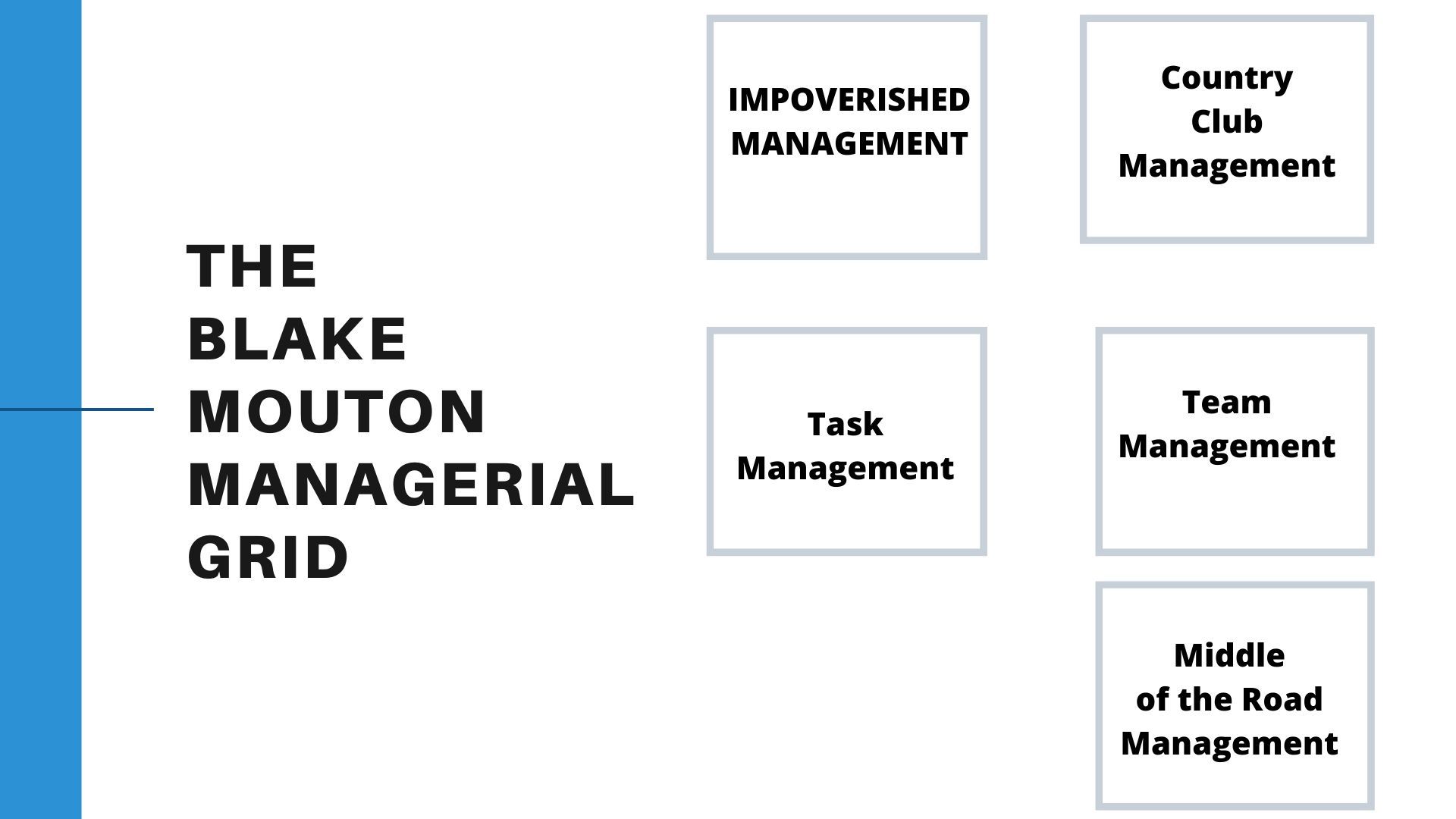
What is the Blake Mouton Managerial Grid and its Advantages and Disadvantages?

Discover the Blake Mouton Managerial Grid, a leadership model that identifies five management styles and their behavioral elements Learn about the advantages and disadvantages of this model, and how it can help you improve your leadership skills
Leadership styles and grids are numerous and diverse, each designed to fulfill specific purposes. It is essential to be familiar with the various styles to effectively navigate the diverse situations that arise in the workplace. Relying on a single style is not enough, as no one style is universally applicable. A successful leader must possess a broad understanding of the distinct leadership styles available.
To effectively choose a leadership style, it is crucial to understand one's natural approach. This understanding enables leaders to identify the style that best aligns with the organization's needs and demands. However, compromising between two approaches can result in a decrease in team efficiency and performance. This compromise fails to fulfill the needs of team members and hinder their ability to achieve excellent and competent results. Neglecting tasks or people is detrimental to organizational growth, as it obstructs goal achievement and meeting company requirements.
The Blake Mouton Managerial Grid, also known as the leadership grid, is a type of grid developed by Robert Blake and Jane Mouton to assess different management styles.
A manager's focus on targeted production, on the other hand, refers to their dedication to achieving organizational goals and meeting performance standards. This involves prioritizing task completion, ensuring productivity, and promoting efficient use of resources. Overall, the Blake and Mouton Managerial Grid emphasizes the importance of balancing concern for both people and production in effective leadership.
Building strong interpersonal relationships is crucial for a leader to effectively manage a team and create a positive work environment. However, it's also important for leaders to prioritize production by evaluating the quality of processes and policies, assessing the creativity of research efforts, and ensuring the effectiveness of all team members.
It also monitors the productivity of teams and individuals, ensuring that the work assigned is efficient and that the output produced is both of high quality and quantity.
Understanding the Blake Mouton Managerial Grid Model
The Blake Mouton Managerial Grid is centered around two key behavioral dimensions: the first is the leader's consideration for their team members' needs, goals, interests, and personal growth. This factor is taken into account when determining strategies to achieve organizational objectives and complete tasks.
The first dimension measures concern for people, and the second dimension measures concern for results. When a leader is high in concern for people, they prioritize the well-being and development of their team members. On the other hand, when a leader is high in concern for results, they prioritize achieving specific goals and driving the organization towards success. The two dimensions work together to create a well-rounded leadership approach that takes into account both the needs of the team and the organization.
Concern for People (y-axis)
Concern for production (x-axis)
The grid is comprised of nine sub-grids, each numbered 1 to 9 and arranged in a square. The numbers represent a scale from low (1) to high (9). The x-axis ranges from Impoverished Management (1) to Task Management (9), while the y-axis ranges from Country Club Management (1) to Team Management (9). The central point of the grid represents Middle of the Road Management.
The grid contains a variety of management styles that work together to improve productivity, efficiency, demand, and overall value for the organization. A leader's position on the grid can depend on their approach to connecting with both people and tasks, taking into consideration personal preferences and the organization's productivity goals.
The Blake Mouton Grid sheds lights on five extremes on the grid as mentioned above, each of which is given a specific name
Impoverished Management
Features: Laissez-Faire style, minimal effort on management, looking out for ways to avoid blame for errors caused by employees.
Concern for people: 1; Concern for task: 1
Country Club Management
Features: Emphasizes on creating a safe, healthy, comfortable working atmosphere for the team members, focus on minimizing conflicts amongst co-workers.
Concern for people: 9; Concern for task: 1
Task Management
Features: Adopts autocratic style, stays at par and consistent with the McGregor Theory X.
Workers are supposed to focus on and complete assigned tasks and nothing else
Concern for people: 1; Concern for task: 9
The team management approach involves actively involving employees in the decision-making process and prioritizing their feelings of value and respect. This approach aligns with McGregor's Theory Y, which emphasizes the importance of trusting and empowering employees to achieve success.
Concern for people: 9; Concern for task: 9
Middle of the Road Management
The style of leadership that involves making trade-offs and concessions to attain satisfactory outcomes and adequate performance is often regarded as less efficient, despite its benefits. This approach is characterized by an equal emphasis on both people and tasks, with a concern score of 5 for each.
Behavioral Elements
: The leadership styles' criteria are tailored depending on the level of importance given to people and tasks. This approach aids in identifying the appropriate values to incorporate into the leadership regime and facilitates their implementation.The Grid theory narrowed it down to seven critical behavioral elements. These are;
Initiative
Inquiry
Advocacy
Decision making
Conflict resolution
Resilience
Critique
Identifying the Managerial Grid Model
Managers were assessed based on the seven essential elements and their performance was used to determine the most suitable leadership style that would effectively meet the production needs of the organization.The managerial grid recognizes various leadership styles based on the two behavioral dimensions mentioned above. They are five to be precise.
1. Impoverished Management
This leadership style, known as impoverished management, is characterized by a lack of concern from the manager or leader towards the work. The manager puts in minimal effort to ensure that the team completes their tasks effectively and efficiently.
lack of innovation, poor quality of products or services, low employee morale, and ultimately, a decline in profits. When leaders are only focused on their own interests, the entire organization suffers. Genuine concern for the well-being of employees and the success of the company should be the driving force behind leadership decisions.
Disharmony among members who are part of the organization
Dissatisfied employees due to lack of appreciation and motivation
The disorganization of the organization that may further lead to jeopardizing the reputation of the company in the industry
2. Task Management
The focus of the leader in this style is solely on achieving production goals, while disregarding the individual needs and concerns of their team members. This approach is often referred to as a dictatorial or authoritarian style, where subordinates are expected to strictly follow instructions from their superiors without question.
The adherence to strict rules and procedures in this particular style may lead to a high turnover rate in the long term. However, it can prove to be advantageous in the short term as it results in rapid growth.
3. Middle of the Road
The balanced approach of the middle of the road style involves the manager considering both the organization's goals and the personal needs of their team. This style strives to maintain a balance between work requirements and employee morale. However, it can be challenging to maintain this equilibrium, which can result in the organization achieving only average levels of performance, as not all demands can be fully met.
4. Country Club
The in-country club style of leadership emphasizes the personal development of subordinates over the tasks and their results. This approach is often favored by managers who aim to cultivate a friendly and healthy work environment for their employees, and also by those who seek to motivate their team members.
By creating a friendly working environment, subordinates can become self-motivated and work more efficiently and effectively. This positive change in attitude leads to increased motivation and enthusiasm for their work.
However, paying less attention to the results can significantly affect the goals, and this may affect the company’s reputation.
5. Team Management
The leadership style that Blake and Mouton refer to as the most effective is one where equal importance is given to both people and production. This approach allows subordinates to work towards achieving goals without constant intervention from their leader, resulting in a higher level of commitment. As per McGregor's Theory Y, this style doesn't require frequent managerial intervention, making it easier for employees to work according to their own schedule and deliver results within the given timeframe.
Trust, empowerment, respect, and commitment are crucial for cultivating strong team relationships, even for leaders. This approach not only boosts employee satisfaction but also enhances overall productivity within the organization. By prioritizing these values, an organization can foster positive internal relationships while also maintaining good relationships with external partners. The managerial grid serves as a visual representation of the various leadership styles that managers and leaders can adopt in their day-to-day operations.
Critical Aspects of the Blake Mouton Grid
The Blake Mouton Managerial Grid is a valuable tool for tailoring leadership styles to fit the unique needs and requirements of an organization. Its impact on team productivity and motivation is significant, and ultimately contributes to a positive working environment.
The correlation between prioritizing "concern for people" and "concern for production" is demonstrated in a graph, indicating that neglecting one aspect in favor of the other can result in inadequate outcomes.
Advantages and Disadvantages of the Blake Mouton Grid Leadership Model
Managers have found success in utilizing the managerial or leadership grid to improve results and productivity. This strategy involves analyzing their leadership styles through grid training. The resulting information can then be utilized to make necessary changes and improvements in leadership tactics.
Grid training operates by having managers answer a questionnaire to determine their level of concern for people and tasks. This enables them to identify areas for improvement and strive for a perfect 9, 9 score through the training. However, while the Blake Mouton Grid model aims to help managers find their ideal leadership style, it overlooks internal and external limitations that can impact their effectiveness. Additionally, it fails to address potential conflicts that may arise from differing perspectives and ideas.
Here is a video byon Blake Mouton Managerial Grid.
To maximize effectiveness within an organization, it is crucial for managers to implement the Blake Mouton Managerial Grid with precision and prioritize the needs of their subordinates equally. As employees reach higher levels of responsibility, it becomes increasingly important to consider their personal needs in order to maintain a positive work environment.
By adopting the Blake Mouton Managerial Grid Model, companies can enhance their leadership style and improve their overall reputation. This approach places equal importance on both the product and production, resulting in increased employee engagement and productivity, ultimately helping the organization reach its desired goals more efficiently. The 1999 seminar on this model introduced a new text titled "The Power to Change," which emphasized the transformative impact of this leadership approach.
Improving the organization's productivity is a crucial aspect that cannot be overlooked. What are your thoughts on the effectiveness of the Blake Mouton Grid model in achieving this goal? Let us know in the comments section.









